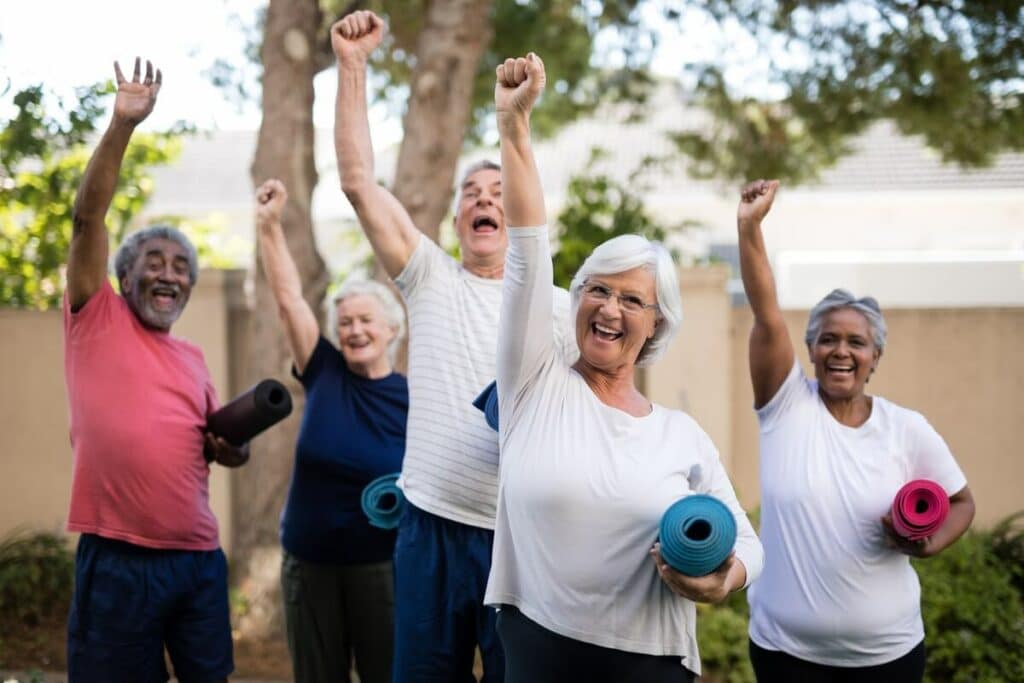Without joints, our bodies would be rigid, and movement would be impossible. As we age, our joints can wear down, leading to discomfort and decreased mobility.
But you don’t have to live with mobility issues, stiffness, and pain. The following can help keep your joints healthy as you age:
- Regular exercise
- A balanced diet
- Weight management
- Correct posture and movement
- Stopping smoking
- Protecting your joints from injuries
Community life in senior living communities can provide comprehensive support for physical and mental health and well-being with tailored programs for healthy aging.
Why Are Joints Important?
Joints are the meeting points of 2 or more bones and are pivotal in facilitating movement while maintaining stability. Your body features various joints: immovable, slightly movable, and freely movable, each constructed differently to serve their unique roles. But what happens when they start to falter with age?
Understanding the structure of your joints is crucial. The components, such as cartilage, synovial fluid, ligaments, and tendons, all support motion and absorb shock. Wear and tear from age can affect these components, compromising joint function and comfort. Older adults might experience joint pain or soreness from standing, climbing stairs, or exercising.
Common Age-Related Joint Issues
Arthritis, in particular, osteoarthritis (OA), also known as degenerative joint disease, is one of the most common joint-related conditions among older adults. OA results when cartilage in the joints breaks down and wears away, leading to the bones rubbing together. Joints affected by OA can include:
- Knees
- Hips
- Hands
- Feet
- Spine
Musculoskeletal changes like diminished muscle tone and bone strength may also lead to joint disorders. Joint deterioration can cause the following symptoms:
- Inflammation
- Pain
- Stiffness
- Difficulty performing certain tasks and activities
Ways to Keep Your Joints Healthy
Preserving your joint health means caring for each component of your body’s complex motion system. Adopting healthy habits now can mean a world of difference for your joints in the future. Small adjustments can have a significant impact.
Regular Exercise
Joints are designed for moving, and staying active is essential for joint health. Regular exercise can help relieve pain and stiffness, strengthen muscles, reduce weight, and improve balance.
However, choosing the correct exercises can avoid joint injury. Low-impact exercises are safe and gentle and promote range of motion and flexibility. Examples can include swimming, cycling, walking, and yoga.
A Balanced Diet for Stronger Joints
Nutrition has a significant impact on your joints. A diet low in processed foods and saturated fats and rich in anti-inflammatory foods, including omega-3 fatty acids and a rainbow of fruits and vegetables, can help promote healthy joints and reduce your risk of developing OA and joint-damaging inflammation.
Weight Management
Every pound counts, especially since it can put extra strain on your joints. Fat can release chemicals that promote inflammation and are related to OA and other forms of arthritis, such as rheumatoid arthritis and gout, that can cause joint damage. Maintaining a healthy weight can reduce the load on your joints and lessen the wear and tear on cartilage as you age.
Correct Posture & Movement
Be mindful of how you carry your body. Bad posture can put abnormal stressors on joints and lead to wear and tear over time. Good posture and proper body mechanics can promote better joint function and prevent the onset of problems. If you have bad posture, a physical therapist can help you improve with exercises.
Stop Smoking
Smoking negatively impacts your bones and joints. Studies show that smoking increases your risk of rheumatoid arthritis.
Protect Your Joints from Injuries
Protect your joints from injury by avoiding repetitive or high-impact activities such as jogging, basketball, or football. For example, an injury to a healthy knee can lead to arthritis later, and an injury to an already arthritic knee can lead to further damage to the joint.
To prevent an injury, you can wear a knee brace for support. If you experience pain in the joint while doing an activity or exercise, stop and rest. See a physical therapist if the pain continues or worsens.
Practice Injury-Avoiding Techniques
Simple actions like bending at the knees to lift something heavy instead of the waist or wearing supportive shoes can protect your joints from unnecessary strain.
Growth and repair happen when your body is at rest. Listen to your body and give it time to recuperate, especially after engaging in activities that can strain your joints.
Continued Joint Care
Physical therapy can strengthen muscles, improve range of motion, and offer pain relief through targeted exercises and techniques. Sometimes, supplements can help promote joint health. Consult a healthcare professional before adding these to your routine.

Healthy Aging for a Fulfilling Life
Don’t wait until your joints give out before taking action. Early detection and intervention can drastically alter the course of many joint-related conditions. By understanding your body and taking proactive steps, you can enjoy an active, pain-free, and healthy life.
If you’re looking for a lifestyle with tailored exercise programs to stay in shape and enjoy life, contact The Legacy at Forest Ridge for more information on our services and amenities.
